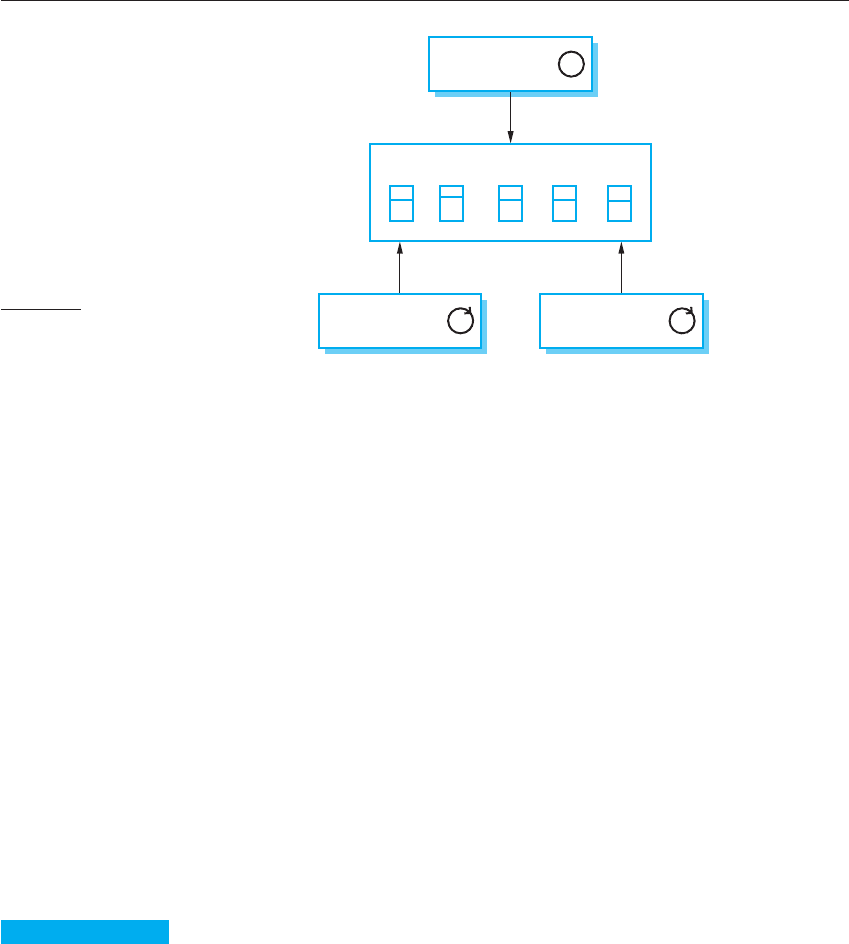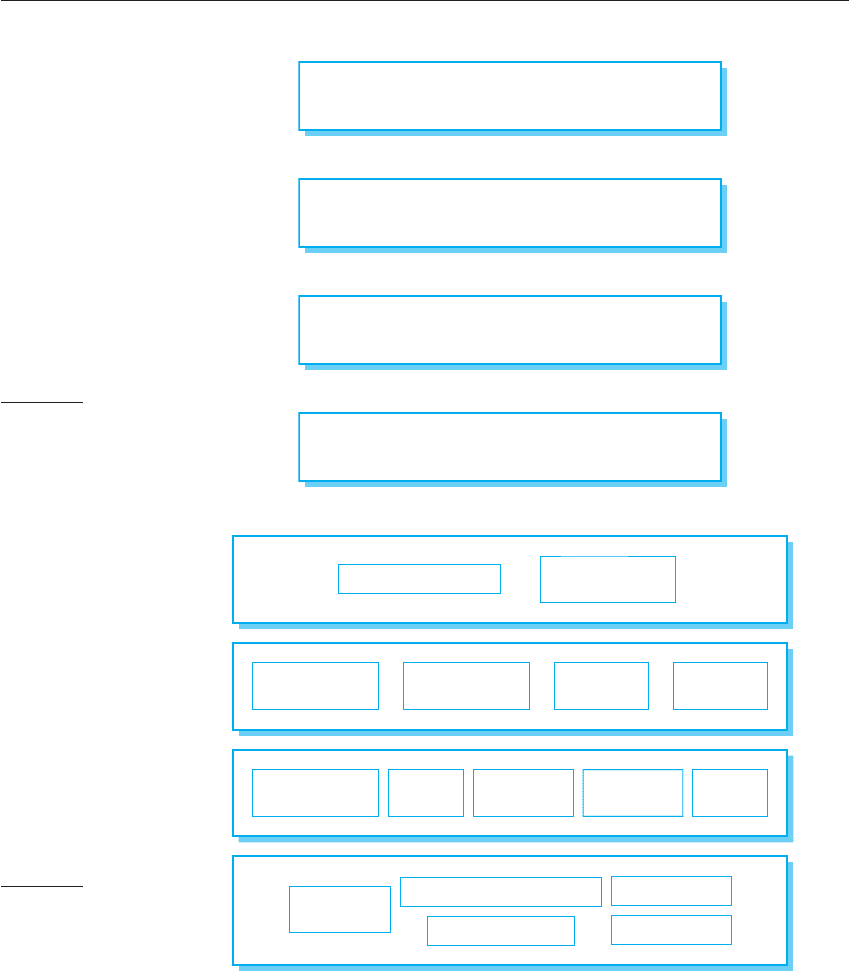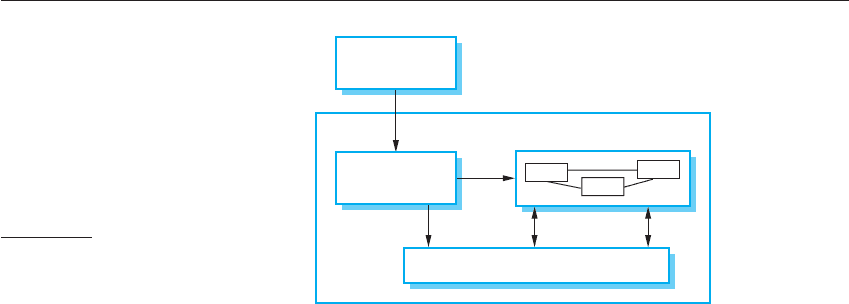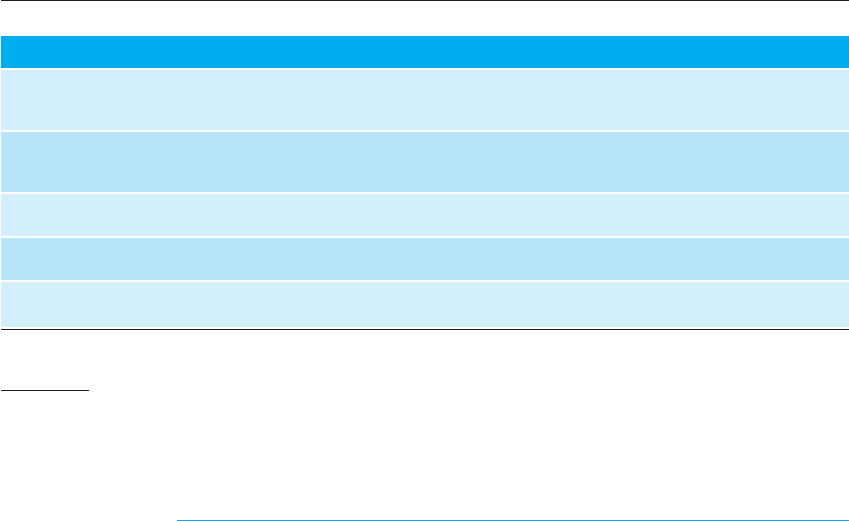Sommerville I. Software Engineering (9th edition)
Подождите немного. Документ загружается.


434 Chapter 16 ■ Software reuse
Application-Specific Classes
Database
Event
Loop
Callbacks Callbacks
Callbacks
Platform
Event
Loop
GUI
Event
Loop
Figure 16.6 Inversion
of control in frameworks
create instances of the system is often a straightforward process. It involves rewriting
concrete classes and methods that you have added to the framework.
However, frameworks are usually more general than software product lines,
which focus on a specific family of application system. For example, you can use a
web-based framework to build different types of web-based applications. One of
these might be a software product line that supports web-based help desks. This
‘help desk product line’ may then be further specialized to provide particular types
of help desk support.
Frameworks are an effective approach to reuse, but are expensive to introduce
into software development processes. They are inherently complex and it can take
several months to learn to use them. It can be difficult and expensive to evaluate
available frameworks to choose the most appropriate one. Debugging framework-
based applications is difficult because you may not understand how the framework
methods interact. This is a general problem with reusable software. Debugging tools
may provide information about the reused system components, which a developer
does not understand.
16.
3
Software product lines
One of the most effective approaches to reuse is to create software product lines or
application families. A software product line is a set of applications with a common
architecture and shared components, with each application specialized to reflect dif-
ferent requirements. The core system is designed to be configured and adapted to
suit the needs of different system customers. This may involve the configuration of
some components, implementing additional components, and modifying some of the
components to reflect new requirements.

16.3 ■ Software product lines 435
Developing applications by adapting a generic version of the application means
that a high proportion of the application code is reused. Furthermore, application
experience is often transferable from one system to another. Consequently, when
software engineers join a development team, their learning process is shortened.
Testing is simplified because tests for large parts of the application may also be
reused, thus reducing the overall application development time.
Software product lines usually emerge from existing applications. That is, an
organization develops an application then, when a similar system is required, infor-
mally reuses code from this in the new application. The same process is used as other
similar applications are developed. However, change tends to corrupt application
structure so, as more new instances are developed, it becomes increasingly difficult to
create a new version. Consequently, a decision to design a generic product line may
then be made. This involves identifying common functionality in product instances
and including this in a base application, which is then used for future development.
This base application is deliberately structured to simplify reuse and reconfiguration.
Application frameworks and software product lines obviously have much in com-
mon. They both support a common architecture and components, and require new
development to create a specific version of a system. The main differences between
these approaches are as follows:
1. Application frameworks rely on object-oriented features such as inheritance and
polymorphism to implement extensions to the framework. Generally, the frame-
work code is not modified and the possible modifications are limited to whatever is
allowed by the framework. Software product lines are not necessarily created using
an object-oriented approach. Application components are changed, deleted, or
rewritten. There are no limits, in principle at least, to the changes that can be made.
2. Application frameworks are primarily focused on providing technical rather
than domain-specific support. For example, there are application frameworks to
create web-based applications. A software product line usually embeds detailed
domain and platform information. For example, there could be a software prod-
uct line concerned with web-based applications for health record management.
3. Software product lines are often control applications for equipment. For exam-
ple, there may be a software product line for a family of printers. This means
that the product line has to provide support for hardware interfacing.
Application frameworks are usually software-oriented and they rarely provide
support for hardware interfacing.
4. Software product lines are made up of a family of related applications, owned
by the same organization. When you create a new application, your starting
point is often the closest member of the application family, not the generic core
application.
If you are developing a software product line using an object-oriented programming
language, then you may use an application framework as a basis for the system. You
create the core of the product line by extending the framework with domain-specific

436 Chapter 16 ■ Software reuse
components using its built-in mechanisms. There is then a second phase of development
where versions of the system for different customers are created.
Various types of specialization of a software product line may be developed:
1. Platform specialization Versions of the application are developed for different
platforms. For example, versions of the application may exist for Windows,
Mac OS, and Linux platforms. In this case, the functionality of the application is
normally unchanged; only those components that interface with the hardware
and operating system are modified.
2. Environment specialization Versions of the application are created to handle
particular operating environments and peripheral devices. For example, a
system for the emergency services may exist in different versions, depending
on the vehicle communications system. In this case, the system components
are changed to reflect the functionality of the communications equipment
used.
3. Functional specialization Versions of the application are created for specific
customers who have different requirements. For example, a library automation
system may be modified depending on whether it is used in a public library, a
reference library, or a university library. In this case, components that imple-
ment functionality may be modified and new components added to the system.
4. Process specialization The system is adapted to cope with specific business
processes. For example, an ordering system may be adapted to cope with a cen-
tralized ordering process in one company and a distributed process in another.
The architecture of a software product line often reflects a general,
application-specific architectural style or pattern. For example, consider a prod-
uct line system that is designed to handle vehicle despatching for emergency
services. Operators of this system take calls about incidents, find the appropriate
vehicle to respond to the incident and dispatch the vehicle to the incident site. The
developers of such a system may market versions of this for police, fire, and
ambulance services.
This vehicle despatching system is an example of a resource management archi-
tecture (Figure 16.7). You can see how this four-layer structure is instantiated in
Figure 16.8, which shows the modules that might be included in a vehicle despatch-
ing system product line. The components at each level in the product line system are
as follows:
1. At the interaction level, there are components providing an operator display
interface and an interface with the communications systems used.
2. At the I/O management level (level 2), there are components that handle
operator authentication, generate reports of incidents and vehicles despatched,
support map output and route planning, and provide a mechanism for operators
to query the system databases.

16.3 ■ Software product lines 437
User Interface
Resource
Tracking
Resource Policy
Control
Resource
Allocation
User
Authentication
Query
Management
Resource
Delivery
Transaction Management
Resource Database
Interaction
I/O Management
Resource Management
Database Management
Figure 16.7 The
architecture of a
resource allocation
system
Operator
Authentication
Vehicle Status
Manager
Incident
Logger
Vehicle
Despatcher
Equipment
Manager
Vehicle
Locator
Map and Route
Planner
Query
Manager
Report
Generator
Operator Interface
Comms System
Interface
Equipment
Database
Vehicle Database
Map Database
Incident Log
Transaction Management
Figure 16.8 The
product line architecture
of a vehicle dispatcher
system
3. At the resource management level (level 3) there are components that allow
vehicles to be located and despatched, components to update the status of vehi-
cles and equipment, and a component to log details of incidents.
4. At the database level, as well as the usual transaction management support,
there are separate databases of vehicles, equipment, and maps.

438 Chapter 16 ■ Software reuse
To create a specific version of this system, you may have to modify individual
components. For example, the police have a large number of vehicles but a small
number of vehicle types, whereas the fire service has many types of specialized
vehicles. Therefore, you may have to define a different vehicle database structure
when implementing a system for these different services.
Figure 16.9 shows the steps involved in extending a software product line to cre-
ate a new application. The steps involved in this general process are as follows:
1. Elicit stakeholder requirements You may start with a normal requirements engi-
neering process. However, because a system already exists, you will need to
demonstrate the system and have stakeholders experiment with it, expressing
their requirements as modifications to the functions provided.
2. Select the existing system that is the closest fit to the requirements When creat-
ing a new member of a product line, you may start with the nearest product
instance. The requirements are analyzed and the family member that is the clos-
est fit is chosen for modification.
3. Renegotiate requirements As more details of required changes emerge and the
project is planned, there may be some requirements renegotiation to minimize
the changes that are needed.
4. Adapt existing system New modules are developed for the existing system and
existing system modules are adapted to meet the new requirements.
5. Deliver new family member The new instance of the product line is delivered to
the customer. At this stage, you should document its key features so that it may
be used as a basis for other system developments in the future.
When you create a new member of product line you may have to find a compro-
mise between reusing as much of the generic application as possible and satisfying
detailed stakeholder requirements. The more detailed the system requirements, the
less likely it is that the existing components will meet these requirements. However,
if stakeholders are willing to be flexible and to limit the system modifications that
are required, you can usually deliver the system more quickly and at a lower cost.
Software product lines are designed to be reconfigured and this reconfiguration
may involve adding or removing components from the system, defining parameters
and constraints for system components, and including knowledge of business
Elicit
Stakeholder
Requirements
Choose
Closest-Fit
System Instance
Deliver New
System Instance
Renegotiate
Requirements
Adapt Existing
System
Figure 16.9 Product
instance development

16.3 ■ Software product lines 439
processes. This configuration may occur at different stages in the development
process:
1. Design-time configuration The organization that is developing the software
modifies a common product line core by developing, selecting, or adapting
components to create a new system for a customer.
2. Deployment-time configuration A generic system is designed for configuration
by a customer or consultants working with the customer. Knowledge of the cus-
tomer’s specific requirements and the system’s operating environment is
embedded in a set of configuration files that are used by the generic system.
When a system is configured at design time, the supplier starts with either a
generic system or an existing product instance. By modifying and extending mod-
ules in this system, they create a specific system that delivers the required customer
functionality. This usually involves changing and extending the source code of the
system so greater flexibility is possible than with deployment-time configuration.
Deployment-time configuration involves using a configuration tool to create a
specific system configuration that is recorded in a configuration database or as a set
of configuration files (Figure 16.10). The executing system consults this database
when executing so that its functionality may be specialized to its execution context.
There are several levels of deployment-time configuration that may be provided
in a system:
1. Component selection, where you select the modules in a system that provide the
required functionality. For example, in a patient information system, you may
select an image management component that allows you to link medical images
(x-rays, CT scans, etc.) to the patient’s medical record.
2. Workflow and rule definition, where you define workflows (how information is
processed, stage by stage) and validation rules that should apply to information
entered by users or generated by the system.
Configuration
Database
System Database
Generic System
Configuration
Planning Tool
Figure 16.10
Deployment-time
configuration

440 Chapter 16 ■ Software reuse
3. Parameter definition, where you specify the values of specific system parame-
ters that reflect the instance of the application that you are creating. For exam-
ple, you may specify the maximum length of fields for data input by a user or
the characteristics of hardware attached to the system.
Deployment-time configuration can be very complex and it may take many
months to configure the system for a customer. Large configurable systems may sup-
port the configuration process by providing software tools, such as a configuration
planning tools, to support the configuration process. I discuss deployment-time con-
figuration further in Section 16.4.1. This covers the reuse of COTS systems that have
to be configured to work in different operational environments.
Design-time configuration is used when it is impossible to use the existing
deployment-time configuration facilities in a system to develop a new system ver-
sion. However, over time, when you have created several family members with
comparable functionality, you may decide to refactor the core product line to
include functionality that has been implemented in several application family
members. You then make that new functionality configurable when the system is
deployed.
16.
4
COTS product reuse
A commercial-off-the-shelf (COTS) product is a software system that can be
adapted to the needs of different customers without changing the source code of the
system. Virtually all desktop software and a wide variety of server products are
COTS software. Because this software is designed for general use, it usually
includes many features and functions. It therefore has the potential to be reused in
different environments and as part of different applications. Torchiano and Morisio
(2004) also discovered that using open source products were often used as COTS
products. That is, the open source systems were used without change and without
looking at the source code.
COTS products are adapted by using built-in configuration mechanisms that
allow the functionality of the system to be tailored to specific customer needs. For
example, in a hospital patient record system, separate input forms and output reports
might be defined for different types of patient. Other configuration features may
allow the system to accept plug-ins that extend functionality or check user inputs to
ensure that they are valid.
This approach to software reuse has been very widely adopted by large companies
over the last 15 or so years, as it offers significant benefits over customized software
development:
1. As with other types of reuse, more rapid deployment of a reliable system may be
possible.

16.4 ■ COTS product reuse 441
2. It is possible to see what functionality is provided by the applications and so it is
easier to judge whether or not they are likely to be suitable. Other companies
may already use the applications so experience of the systems is available.
3. Some development risks are avoided by using existing software. However, this
approach has its own risks, as I discuss below.
4. Businesses can focus on their core activity without having to devote a lot of
resources to IT systems development.
5. As operating platforms evolve, technology updates may be simplified as these
are the responsibility of the COTS product vendor rather than the customer.
Of course, this approach to software engineering has its own problems:
1. Requirements usually have to be adapted to reflect the functionality and mode
of operation of the COTS product. This can lead to disruptive changes to exist-
ing business processes.
2. The COTS product may be based on assumptions that are practically impossible
to change. The customer must therefore adapt their business to reflect these
assumptions.
3. Choosing the right COTS system for an enterprise can be a difficult process,
especially as many COTS products are not well documented. Making the wrong
choice could be disastrous as it may be impossible to make the new system work
as required.
4. There may be a lack of local expertise to support systems development.
Consequently, the customer has to rely on the vendor and external consultants
for development advice. This advice may be biased and geared to selling prod-
ucts and services, rather than meeting the real needs of the customer.
5. The COTS product vendor controls system support and evolution. They may go
out of business, be taken over, or may make changes that cause difficulties for
customers.
Software reuse based on COTS has become increasingly common. The vast
majority of new business information processing systems are now built using
COTS rather than using an object-oriented approach. Although there are often
problems with this approach to system development (Tracz, 2001), success stories
(Baker, 2002; Balk and Kedia, 2000; Brownsword and Morris, 2003; Pfarr and
Reis, 2002) show that COTS-based reuse reduces effort and the time to deploy the
system.
There are two types of COTS product reuse, namely COTS-solution systems and
COTS-integrated systems. COTS-solution systems consist of a generic application
from a single vendor that is configured to customer requirements. COTS-integrated
systems involve integrating two or more COTS systems (perhaps from different

442 Chapter 16 ■ Software reuse
vendors) to create an application system. Figure 16.11 summarizes the differences
between these different approaches.
16.4.1 COTS-solution systems
COTS-solution systems are generic application systems that may be designed to
support a particular business type, business activity, or sometimes, a complete
business enterprise. For example, a COTS-solution system may be produced for
dentists that handles appointments, dental records, patient recall, etc. At a larger
scale, an Enterprise Resource Planning (ERP) system may support all of the man-
ufacturing, ordering, and customer relationship management activities in a large
company.
Domain-specific COTS-solution systems, such as systems to support a business
function (e.g., document management), provide functionality that is likely to be
required by a range of potential users. However, they also incorporate built-in
assumptions about how users work and these may cause problems in specific situa-
tions. For example, a system to support student registration in a university may
assume that students will be registered for one degree at one university. However, if
universities collaborate to offer joint degrees, then it may be practically impossible
to represent this in the system.
ERP systems, such as those produced by SAP and BEA, are large-scale inte-
grated systems designed to support business practices such as ordering and invoic-
ing, inventory management, and manufacturing scheduling (O’Leary, 2000). The
configuration process for these systems involves gathering detailed information
about the customer’s business and business processes, and embedding this in a con-
figuration database. This often requires detailed knowledge of configuration nota-
tions and tools and is usually carried out by consultants working alongside system
customers.
A generic ERP system includes a number of modules that may be composed
in different ways to create a system for a customer. The configuration process
Figure 16.11 COTS-
solution and COTS-
integrated systems
COTS-solution systems COTS-integrated systems
Single product that provides the functionality
required by a customer
Several heterogeneous system products are
integrated to provide customized functionality
Based around a generic solution and standardized
processes
Flexible solutions may be developed for customer
processes
Development focus is on system configuration Development focus is on system integration
System vendor is responsible for maintenance System owner is responsible for maintenance
System vendor provides the platform for the system System owner provides the platform for the system

16.4 ■ COTS product reuse 443
involves choosing which modules are to be included, configuring these
individual modules, defining business processes and business rules, and defining
the structure and organization of the system database. A model of the overall archi-
tecture of an ERP system that supports a range of business functions is shown in
Figure 16.12.
The key features of this architecture are:
1. A number of modules to support different business functions. These are large-
grain modules that may support entire departments or divisions of the business.
In the example shown in Figure 16.12, the modules that have been selected for
inclusion in the system are a module to support purchasing, a module to support
supply chain management, a logistics module to support the delivery of goods,
and a customer relationship management (CRM) module to maintain customer
information.
2. A defined set of business processes, associated with each module, which relate
to activities in that module. For example, there may be a definition of the order-
ing process that defines how orders are created and approved. This will specify
the roles and activities involved in placing an order.
3. A common database that maintains information about all related business func-
tions. This means that it should not be necessary to replicate information, such
as customer details, in different parts of the business.
4. A set of business rules that apply to all data in the database. Therefore, when
data is input from one function, these rules should ensure that it is consistent
with the data required by other functions. For example, there may be a business
rule that all expense claims have to be approved by someone more senior than
the person making the claim.
ERP systems are used in almost all large companies to support some or all of their
functions. They are, therefore, a very widely used form of software reuse. However,
the obvious limitation of this approach to reuse is that the functionality of the system
System Database
Business Rules
Purchasing
Processes
Supply Chain
Processes
Logistics
Processes
CRM
Processes
Figure 16.12 The
architecture of an ERP
system
